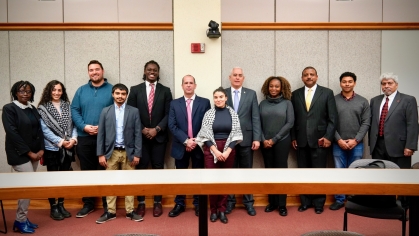Silly Talk Directed at Infants May Be More Educational than Imagined
Rutgers University-Newark mathematicians’ analysis finds “motherese” sounds are easier to learn.
Many experts on infant learning have suggested that the best way to teach adult language to a tiny baby is to speak as if the infant is another adult – because adult sounds, cadence and tone of voice are what the child is eventually supposed to learn. But newly published research using mathematical models finds the best way to help a baby learn might actually be to follow many parents' instincts and use “motherese,” a sing-songy voice that exaggerates the sounds the baby hears.
“Our intuitions are surprisingly right,” says Patrick Shafto, an associate professor of mathematics and computer science at Rutgers University-Newark (RU-N), who conducted the research – which is published in Psychological Review – with postdoctoral fellow Baxter Eaves. “Why do we speak funny to children? It’s actually to help them learn the relevant properties of language.”
Shafto, Eaves and colleagues deconstructed vowel sounds in adult speech. They then created a mathematical model that predicted understandable speech patterns from scratch, “to show what it might look like if speech were designed to actually teach children.” They then compared their invented teaching pattern with the differing speech methods that adults direct at each other and at infants, and found that infant-directed speech was the closer match.
“The sounds that are selected exaggerate the important properties that babies need to attend to and learn about,” Shafto says. “If you exaggerate in the correct way, what you get is a learner who learns more quickly from less data.” It makes sense to Shafto that over time the baby’s brain is then able to process the “motherese” into regular language.
Shafto, who also is Henry Rutgers Term Chair in computer science and on the faculty of RU-N’s College of Arts and Sciences, says his mathematical model is an elegant way to think about infants’ learning. This work, he cautions, is also preliminary. For instance, proving that infant-directed speech is more educational is difficult by definition because babies not even a year old are too young to speak, so it is challenging to probe any language skills they have learned.
But there may be a different group of learners who could demonstrate the value of a mathematical learning model. Shafto says American adults don’t only speak in exaggerated ways to infants. They also distort their speech with pets and with foreign language speakers – but they do it differently for each. Pets hear sing-songy voices with no effort by the speaker to exaggerate vowels to make the animals understand – a pure play to cuteness that differs from speech intended to teach a baby. Foreigners get the opposite – no condescending sing-song, but a concerted effort to exaggerate vowel sounds – the better to help the listener understand a language he or she doesn’t know.
Because foreign language speakers’ learning of English can be measured, Shafto says it might be possible to use mathematics to fine tune the speech patterns of instructors in ways that enhance the teaching of English as a second language. “By manipulating only the things that are important and highlighting the meaningful distinctions in the language,” he says, “we might be able to make English more learnable for someone who speaks a different language natively.”
According to Shafto, the bottom line of this new study, and of the work he is doing, is that math and the study of language learning go extremely well together. “Learning these vowel categories is a complicated problem,” he says. “There are lots of moving parts, so it’s not the sort of thing that one can easily intuit.”
“I think it’s a nice example of why mathematical rigor is important in areas where you least expect it,” Shafto adds, “such as understanding why we talk silly to children.”
Photo of Patrick Shafto (right) and Baxter Eaves by Nora Luongo


